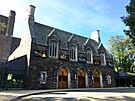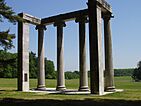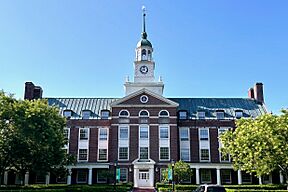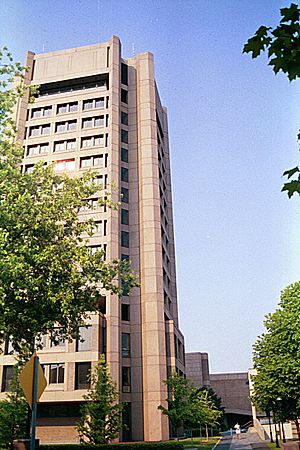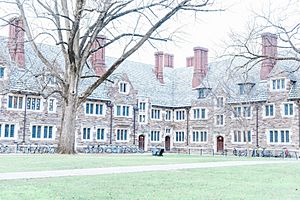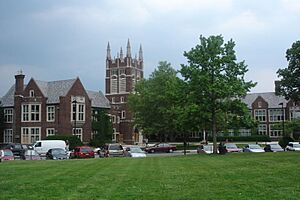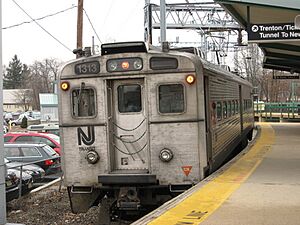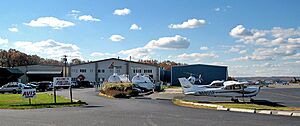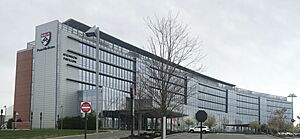Princeton, New Jersey facts for kids
Quick facts for kids
Princeton, New Jersey
|
||
|---|---|---|
|
Borough
|
||
| The Municipality of Princeton | ||
|
Lower Pyne building on the corner of Nassau Street and Witherspoon Street, 2015
Nassau Street northbound in Downtown Princeton, 2017
Princeton station, 2020
McCarter Theatre, 2018
Nassau Hall on the campus of Princeton University, 2019
Princeton Battlefield, 2007
Palmer Square, 2013
|
||
|
||
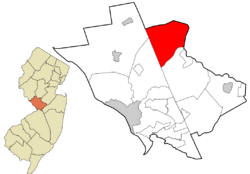
Location of Princeton in Mercer County and in New Jersey
|
||
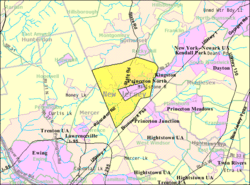
Census Bureau map of the former Princeton Township (and enclaved Borough in pink), New Jersey
<mapframe text="Interactive map of Princeton, New Jersey" zoom="8" width="250" height="250"> { "type": "ExternalData", "service": "geoshape", "ids": "Q138518" } </mapframe> |
||
| Country | ||
| State | ||
| County | Mercer | |
| Incorporated | January 1, 2013 | |
| Government | ||
| • Type | Borough | |
| Area | ||
| • Total | 18.41 sq mi (47.69 km2) | |
| • Land | 17.95 sq mi (46.48 km2) | |
| • Water | 0.47 sq mi (1.21 km2) 2.53% | |
| Area rank | 154th of 565 in state 6th of 12 in county |
|
| Population
(2020)
|
||
| • Total | 30,681 | |
| • Estimate
(2023)
|
30,289 | |
| • Rank | 78th of 565 in state 5th of 12 in county |
|
| • Density | 1,709.6/sq mi (660.1/km2) | |
| • Density rank | 319th of 565 in state 8th of 12 in county |
|
| Time zone | UTC−05:00 (Eastern (EST)) | |
| • Summer (DST) | UTC−04:00 (Eastern (EDT)) | |
| ZIP Codes |
08540–08544
|
|
| Area code(s) | 609 | |
| FIPS code | 3402160900 | |
Princeton is a town in Mercer County, New Jersey. It became one single town on January 1, 2013. Before that, it was two separate areas: the Borough of Princeton and Princeton Township.
In 2020, about 30,681 people lived in Princeton. This was an increase from 28,572 people in 2010.
Princeton was founded before the American Revolutionary War. It is famous for being home to Princeton University. This university is one of the world's top schools. It moved to Princeton in 1756. Other important places here include the Institute for Advanced Study and the Princeton Theological Seminary.
Princeton is located almost exactly halfway between New York City and Philadelphia. It is also close to major roads like Interstate 95 and U.S. Route 1. New Jersey's capital city, Trenton, is also nearby.
Since 1945, the official home of New Jersey's governor has been in Princeton. The first governor's mansion was called Morven. Later, Drumthwacket became the new official residence in 1982. Morven is now a museum and garden.
For a long time, Princeton was divided into two parts: a township and a borough. The borough was in the middle, surrounded by the township. They split up in 1894 over school taxes. However, they later joined some services like schools. They finally reunited into one Princeton in 2013.
Contents
History of Princeton
How Princeton Began
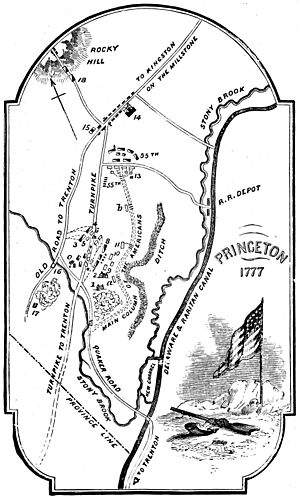
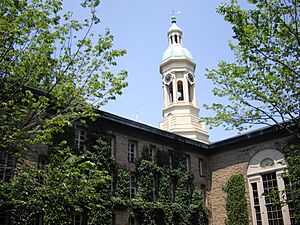
The first people to live in the Princeton area were the Lenape Native Americans.
Europeans started settling here in the late 1600s. They came from both Delaware and New York. The area that became Princeton was in the wilderness between these two places. Henry Greenland built the first European house and a tavern in 1683.
Princeton was first known as part of nearby Stony Brook. The name "Princeton" was first used in 1724. It became common over the next ten years. Many believe it was named after Prince William of Orange. Other towns nearby also have royal names, like Kingston.
Princeton did not grow very large until the College of New Jersey arrived. This college is now Princeton University. It moved to the town in 1756. The town's population grows a lot when students are in school.
Princeton's Role in the American Revolution
In January 1777, George Washington led his army to a big victory in the Battle of Princeton. This win made the British leave southern New Jersey. After the battle, Princeton hosted the first meeting of New Jersey's government.
Two people who signed the United States Declaration of Independence lived in Princeton. They were Richard Stockton and John Witherspoon. Princeton has streets named after them today.
In 1938, a group of citizens started the "Historical Society of Princeton." They used the Bainbridge House for this purpose. This house was built in 1766. It was even used for a meeting of the Continental Congress in 1783. The house still has many of its original features.
Princeton's Location and Climate
Where is Princeton Located?
Princeton is just south of a long hill called Princeton Ridge. The town is in a lower area. This can sometimes cause problems with cell phone signals.
Princeton covers about 18.41 square miles (47.69 square kilometers). Most of this area is land.
Some smaller communities have become part of Princeton over time. These include Cedar Grove and Port Mercer. They still keep their unique local feel.
Princeton shares borders with several other towns. These include Hopewell Township and Lawrence Township. It also borders towns in Middlesex and Somerset Counties.
Princeton's Weather and Seasons
Princeton has a climate with warm summers and cold winters. Sometimes in summer, it can get very hot and humid. The wettest month is usually July. This is when many thunderstorms happen.
In winter, it can get very cold and windy. The average snowfall each year is about 24 to 30 inches. February is usually the snowiest month. This is when big winter storms called "nor'easters" often occur.
| Climate data for Princeton Municipal Court, Mercer County, NJ (1991–2020 Averages) | |||||||||||||
|---|---|---|---|---|---|---|---|---|---|---|---|---|---|
| Month | Jan | Feb | Mar | Apr | May | Jun | Jul | Aug | Sep | Oct | Nov | Dec | Year |
| Mean daily maximum °F (°C) | 39.8 (4.3) |
42.3 (5.7) |
50.2 (10.1) |
62.6 (17.0) |
72.2 (22.3) |
81.4 (27.4) |
86.1 (30.1) |
84.2 (29.0) |
77.7 (25.4) |
65.8 (18.8) |
54.9 (12.7) |
44.7 (7.1) |
63.5 (17.5) |
| Daily mean °F (°C) | 31.2 (−0.4) |
33.2 (0.7) |
40.6 (4.8) |
51.7 (10.9) |
61.5 (16.4) |
70.6 (21.4) |
75.5 (24.2) |
73.8 (23.2) |
66.9 (19.4) |
55.2 (12.9) |
44.9 (7.2) |
36.3 (2.4) |
53.2 (11.8) |
| Mean daily minimum °F (°C) | 22.7 (−5.2) |
24.1 (−4.4) |
31.0 (−0.6) |
40.9 (4.9) |
50.7 (10.4) |
59.9 (15.5) |
65.0 (18.3) |
63.3 (17.4) |
56.2 (13.4) |
44.5 (6.9) |
34.8 (1.6) |
27.8 (−2.3) |
42.9 (6.1) |
| Average precipitation inches (mm) | 3.41 (87) |
2.69 (68) |
4.07 (103) |
4.14 (105) |
4.19 (106) |
4.25 (108) |
5.40 (137) |
4.02 (102) |
4.36 (111) |
4.00 (102) |
3.71 (94) |
4.03 (102) |
48.27 (1,226) |
| Average relative humidity (%) | 66.0 | 62.3 | 58.3 | 58.2 | 63.0 | 67.4 | 67.5 | 70.0 | 71.2 | 70.2 | 68.4 | 67.8 | 65.9 |
| Average dew point °F (°C) | 20.5 (−6.4) |
21.8 (−5.7) |
27.3 (−2.6) |
37.2 (2.9) |
48.3 (9.1) |
59.1 (15.1) |
63.6 (17.6) |
63.1 (17.3) |
56.5 (13.6) |
45.1 (7.3) |
35.3 (1.8) |
25.8 (−3.4) |
42.1 (5.6) |
| Source: PRISM Climate Group | |||||||||||||
People and Population of Princeton
| Historical population | |||
|---|---|---|---|
| Census | Pop. | %± | |
| 2010 | 28,572 | — | |
| 2020 | 30,681 | 7.4% | |
| 2023 (est.) | 30,289 | 6.0% | |
| Population sources: 2010-2020 | |||
In 2010, the combined population of the former borough and township was 28,572 people.
Princeton has a diverse population. Most residents are White (about 67.6%). About 15.4% are Asian, and 8.4% are Hispanic. Chinese, Spanish, and French are common foreign languages spoken.
Education in Princeton
Colleges and Universities in Princeton
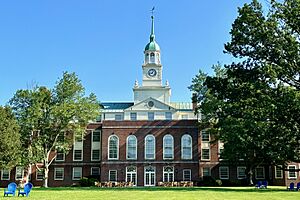
Princeton University is a very important part of the community. It is one of the world's leading research universities. The university was founded in 1746. Its main campus is centered around Nassau Street. Princeton University is often ranked as one of the best universities in the U.S.
Princeton Theological Seminary is the oldest seminary of the Presbyterian Church in America. Its main campus is also in Princeton.
The Institute for Advanced Study owns a large area of land called the "Institute Woods." This area covers 800 acres.
Mercer County Community College is a two-year public college. It serves Princeton residents and others from Mercer County. It is located in nearby West Windsor.
Westminster Choir College used to be in Princeton. It is a music school owned by Rider University. In 2020, all its activities moved to Rider's main campus.
Schools for Younger Students
Public Schools in Princeton
The Princeton Public Schools serve students from pre-kindergarten through 12th grade. Students from Cranbury Township also attend Princeton High School. The district has six schools.
- Community Park School (grades K-5)
- Johnson Park School (grades PreK-5)
- Littlebrook School (grades K-5)
- Riverside School (grades PreK-5)
- Princeton Middle School (grades 6-8)
- Princeton High School (grades 9-12)
Princeton High School is often ranked as one of the best high schools in New Jersey.
The Princeton Charter School is a public school that operates independently. It serves students from kindergarten to 8th grade.
Students in 8th grade from Mercer County can apply to the Mercer County Technical Schools. These schools offer special career and technical programs.
Private Schools in Princeton
Princeton has several private schools. Some of these include:
- The Lewis School of Princeton
- Princeton Day School
- Princeton Friends School
- Hun School of Princeton
- Princeton International School of Mathematics and Science (PRISMS)
St. Paul's Catholic School is a coeducational Catholic school. It serves students from pre-school to 8th grade.
Public Libraries in Princeton
The Princeton Public Library is located on Witherspoon Street. It opened its current building in 2004. The library itself was founded in 1909.
Getting Around Princeton
Roads and Highways in Princeton
Princeton has many miles of roads. Most are maintained by the town. Major roads like U.S. Route 206 and Route 27 pass through Princeton.
Other important roads are close by. These include U.S. Route 1 and Interstate 295. The New Jersey Turnpike is also easily accessible.
Public Transportation in Princeton
Princeton is about the same distance from New York City and Philadelphia. It has train connections to both cities. The Princeton Branch rail line connects to the Princeton Junction station. From there, you can take NJ Transit trains to New York.
NJ Transit also provides bus service to Trenton. Coach USA Suburban Transit offers frequent bus service to New York City.
Princeton and Princeton University also have local bus services. These are called FreeB and Tiger Transit.
Airports Near Princeton
Princeton Airport is a public airport. It is located about 3 miles north of downtown Princeton.
The closest commercial airport is Trenton-Mercer Airport. It is about 15 miles from Princeton. Larger airports like Newark Liberty International Airport and Philadelphia International Airport are also nearby.
Healthcare in Princeton
Penn Medicine Princeton Medical Center (PMC) is a hospital in nearby Plainsboro Township. It serves the Princeton area. PMC is a large hospital with 355 beds. It is part of the Penn Medicine Health System.
The hospital used to be in Princeton. It moved to its new location in Plainsboro in 2012.
Other hospitals nearby include Robert Wood Johnson University Hospital in New Brunswick.
Sister Cities
Princeton has two sister cities:
- Colmar, France
- Pettoranello del Molise, Italy
Notable People from Princeton
Many interesting people have lived in or are connected to Princeton. This list does not include people who only studied at Princeton University.
- George Akerlof (born 1940), a Nobel Prize winner in economics.
- Albert Einstein (1879–1955), a famous physicist. He lived in Princeton for many years.
- Ethan Hawke (born 1970), a well-known actor.
- John Lithgow (born 1945), an actor, lived in Princeton as a teenager.
- Thomas Mann (1875–1955), a famous author.
- John McPhee (born 1931), a writer who lives in Princeton.
- Toni Morrison (1931–2019), a Nobel Prize-winning author and professor at Princeton University.
- John Forbes Nash Jr. (1928–2015), a mathematician and Nobel Prize winner. The movie A Beautiful Mind is about him.
- Bebe Neuwirth (born 1958), an actress who grew up in Princeton.
- J. Robert Oppenheimer (1904–1967), a theoretical physicist.
- Paul Robeson (1898–1976), a singer, actor, and civil rights activist. He was born and raised in Princeton.
- Christopher Reeve (1952–2004), an actor famous for playing Superman. He grew up in Princeton.
- Peter Singer (born 1946), a moral philosopher and professor.
- Richard Stockton (1730–1781), a signer of the United States Declaration of Independence.
- Woodrow Wilson (1856–1924), the 28th President of the United States. He was also the president of Princeton University.
- John Witherspoon (1723–1794), a signer of the United States Declaration of Independence and president of Princeton University.
Places to Visit in Princeton

Churches in Princeton
- Nassau Christian Center
- Nassau Presbyterian Church
- Princeton United Methodist Church
- Princeton University Chapel
- St Paul's Roman Catholic Church
- Stone Hill Church of Princeton
- Stony Brook Meeting House and Cemetery
- Trinity Church, Princeton
- Princeton Seventh-Day Adventist Church
Educational Institutions to See
- Institute for Advanced Study and Institute Woods
- Princeton Theological Seminary
- Princeton University
Museums in Princeton
- Morven
- Princeton University Art Museum
Historic Sites to Explore
- Albert Einstein House: This was the home of Albert Einstein from 1936 until his death in 1955.
- Drumthwacket: The official home of the governor of New Jersey.
- Jasna Polana
- Jugtown Historic District: A group of old buildings from colonial times.
- King's Highway Historic District
- Kingston Mill Historic District
- Maybury Hill: The childhood home of Joseph Hewes, a signer of the United States Declaration of Independence.
- Mountain Avenue Historic District
- Nassau Club
- Nassau Hall
- Nassau Inn
- Princeton Battlefield State Park
- Princeton Battle Monument
- Princeton Cemetery
- Princeton Historic District
- Princeton Ice Company
- Tusculum
- Updike Farmstead
- The Washington Oak
- Westland Mansion
- Witherspoon Street School for Colored Children
Parks and Outdoor Areas
- The Delaware and Raritan Canal State Park: This park has a 9-acre Turning Basin Park and miles of trails for biking and hiking.
- Herrontown Woods Arboretum
- Lake Carnegie
- Marquand Park
- Mountain Lakes Preserve
- Palmer Square
- Princeton Battlefield State Park
- Small "pocket parks" in the downtown area:
- Barbara Boggs Sigmund Garden
- David Bradford Park
- Harrison Street Park
- Mary Moss Park
- Potts Park
Restaurants to Visit
- Elements
- Peacock Inn
- Whole Earth Center
Local News and Media
- Princeton Packet
- Princeton Town Topics
- Planet Princeton
See also
 In Spanish: Princeton (Nueva Jersey) para niños
In Spanish: Princeton (Nueva Jersey) para niños





